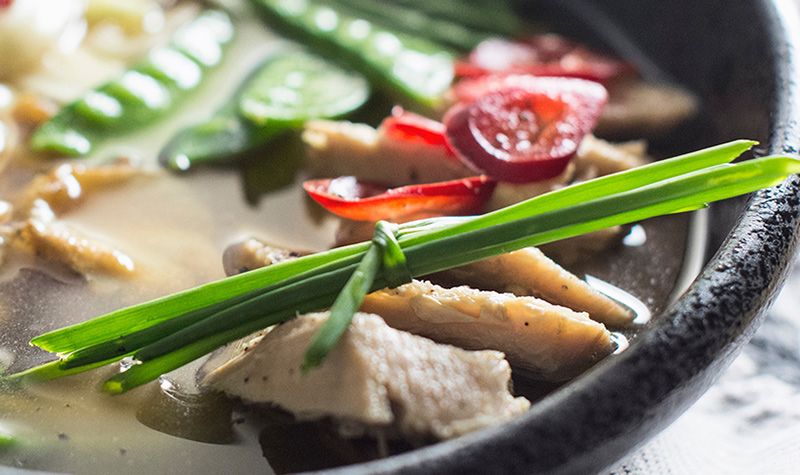Be a Plant-Forward Player
Published on: 01/29/2020 in College & University, Culinary Trends
Published on: 01/29/2020 in College & University, Culinary Trends

Media and industry buzz around plant-based meat alternatives has reached a fever pitch. Whether you’re a supporter or a skeptic, enthusiasts’ underlying motivation—the desire for food that’s simultaneously healthier and more flavorful—should inform your future menus and marketing.
Indeed, a movement toward healthful, plant-forward diets—emphasizing cooking with and eating more fruits, vegetables, whole grains, beans, pulses, soy, nuts, seeds, plant oils, herbs and spices without eliminating meat—is solidly underway.
Public readiness for plant-forward is apparent not in the number of consumers who are vegetarian or vegan (only 5 percent and 3 percent, respectively), but rather in the one-third of Americans who consider themselves “flexitarians”—defined as people who would like to eat more vegetables but also love eating meat.1 Of this group, 70 percent believe a flexitarian diet gives them the ability to eat healthier without feeling deprived.2 That feeling helped restaurants increase sales of meat-alternative products by 268 percent between 2018 and 2019.3
The plant-forward trend is the collective work of three different stakeholders. In one corner of influence are the aforementioned consumers who describe themselves as flexitarians, including 27 percent of the college-aged public.4 In another corner are industry powerhouses like the Culinary Institute of America, which host industry events like the Global Plant-Forward Culinary Summit and Menus of Change that are devoted to outlining ways for the foodservice industry to build a more plant-friendly future.5 Finally, you have a growing number of operators who are making a plant-forward value statement.
Together, the efforts of consumers, educators and operators offer a roadmap for how to create and market plant-centric fare. Here are three smart strategies:
First Watch has tweaked its breakfast menu to include more plant-based items, including avocado toast and its A.M. Superfoods Bowl. But the chain won’t use the term “plant-based.” Vice President of Culinary Strategy Shane Schaibly tells Nation’s Restaurant News that “plant-based” could alienate meat lovers; the company therefore calls plant-forward dishes “veggie-centric” instead.6 Its menu lists the items in a section titled “The Healthier Side.”
Other palatable terms to consider are “plant-rich” or “more plant-based.” As the term flexitarian becomes more popular, it also could become a viable menu marketing term.
Instead of succumbing to obvious choices like veggie patties or plant-based burgers, consider following the lead of companies that are blending poultry and other animal proteins with vegetables. Mushrooms, for example, are currently in the spotlight for their umami flavor. In fact, the Mushroom Council trademarked the protein-and-mushroom mash-up and partnered with the James Beard Foundation to make it the centerpiece of the annual Blended Burger Project. Together, the two organizations encourage operators to develop their own blend composed of at least 25 percent mushrooms.
Boston-based fast-casual operator B.GOOD recently added what it calls flexitarian burgers as part of its “food with roots” mission. One of them, the Turkey Medley, combines ground turkey and mushrooms. “By consuming a little less meat, you’re also supporting the environment!” reads a company statement. “Less meat=less resources used to produce. So, do a little good for the Earth and a whole lot of good for your stomach.”
Grain bowls may be one of the most promising dishes to create and market as plant-forward. In September 2019, for example, Panera Bread launched two warm grain bowls that were inspired by international flavors and designed to fit into a flexitarian diet. The Baja and Mediterranean bowls are “the next step in Panera’s evolving mission to offer more grains, plants and proteins on its menu, with a focus on delivering craveable food that makes you feel not just full, but fulfilled,” the company said.
Scout for protein-rich ingredients that would work well on your menu as part of a bowl-based meal. For example, consider popular options like quinoa, amaranth, chickpeas and other beans, lentils and tofu.7 Other options include emerging proteins like pili, coconut amino acids, jackfruit and Irish moss.1
As you apply the plant-forward ethos, remember: Your goal is to reach flexitarians by reducing rather than eliminating animal proteins such as chicken and turkey, which pair exceptionally well with plant-based ingredients. When you market items plant-forward dishes, be generous with terms like “clean,” “wholesome,” “environmentally friendly,” “thoughtful” and “delicious” that appeal to all guests—no matter their meat-eating habits.
Sources: